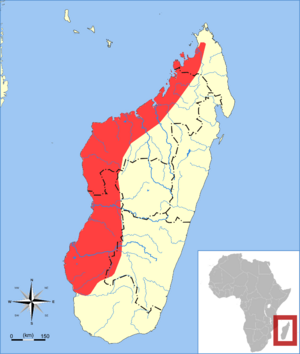Black and red free-tailed bat facts for kids
Quick facts for kids Black and red free-tailed bat |
|
|---|---|
| Conservation status | |
| Scientific classification | |
| Genus: |
Mops
|
| Species: |
jobimena
|
 |
|
| Range | |
| Synonyms | |
|
Tadarida jobimena (Goodman & Cardiff, 2004) |
|
The Mops jobimena, also known as the black and red free-tailed bat, is a special type of bat. It belongs to the Molossidae family, which are often called "free-tailed bats" because their tails stick out from the edge of their tail membrane. This bat is found only in western Madagascar. It's a medium-sized bat, with its forearm measuring about 45 to 48 millimeters (1.8 to 1.9 inches).
Contents
Where It Lives (Habitat)
The black and red free-tailed bat likes to live in warm, dry places. You can find it in tropical dry forests and spiny forests. These areas are usually between 50 and 870 meters (about 164 to 2,854 feet) above sea level.
These bats don't usually live in caves. Instead, they prefer to rest or "roost" in trees. They also sometimes make their homes in houses and other buildings.
Its Family Tree (Taxonomy)
Even though this bat is currently called Mops jobimena and looks a lot like other Mops bats, scientists have found something interesting. By looking at its DNA (molecular evidence), they discovered its closest relatives are actually two other bats: Tadarida aegyptiaca from Africa and Asia, and Tadarida brasiliensis from the Americas.
These three bats are like a close family group that started about 9.8 million years ago. The black and red free-tailed bat and Tadarida aegyptiaca are like "sister species," meaning they are very closely related. This shows that even if animals look similar, their family history can sometimes be quite different! The similar looks might be due to parallel or convergent evolution, where different species develop similar traits because they live in similar environments.
Is It Safe? (Conservation Status)
Good news for the black and red free-tailed bat! Even though you don't see them everywhere, they live across a wide area. This area includes four places that are protected, like national parks. Scientists also believe these bats don't need untouched forests to survive.
Because of these reasons, the IUCN (International Union for Conservation of Nature) has listed the black and red free-tailed bat as being of 'least concern'. This means they are not currently in danger of disappearing. However, in southern Madagascar, some people might hunt them for food, which could be a small threat.
See also
- List of bats of Madagascar


